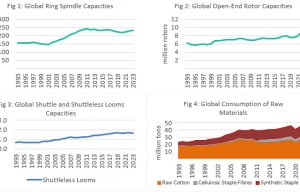
Installed OE rotor positions approach ten million
This report includes detailed statistical data showing the volume of man-made fibre consumed in the US manufacture of finished textile products.

18th March 2015
Innovation in Textiles
|
This report includes detailed statistical data showing the volume of man-made fibre consumed in the US manufacture of finished textile products for industrial end uses, non-industrial end uses and other consumer markets. In addition, the data are broken down by fibre type.
The volume of man-made fibre consumed in the manufacture of finished textile products in the USA rose in 2013 to its highest level since 2008.
There was an increase in synthetic filament yarn consumption and synthetic staple fibre consumption but consumption of cellulosic staple fibre and cellulosic filament yarn fell. In industrial applications, man-made fibre consumption was greatest in the manufacture of fibrefill, stuffing and flock although consumption was down compared with the previous year.
However, there were increases in consumption for eleven end uses, namely bags and bagging, belting, coated and protective fabrics, felts, filtration, miscellaneous end uses, paper and tape reinforcing, rope and cordage, sewing thread, transportation fabrics and tyres. In non-industrial applications, there was a rise in the consumption of man-made fibre for floor coverings production, home textiles production and apparel manufacture.
Publisher: Textiles Intelligence
15 pages, published 4th quarter 2014
Report price: Euro 395.00; US$ 520.00
Reports are supplied in PDF format only via email and can be purchased by credit card or via PayPal. Alternatively readers can email their order and we will invoice accordingly and send their report by email upon receipt of payment.
To buy this report, please select one of the buttons below or email [email protected] .

Business intelligence for the fibre, textiles and apparel industries: technologies, innovations, markets, investments, trade policy, sourcing, strategy...
Find out more